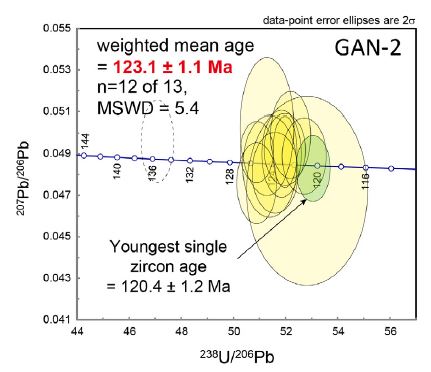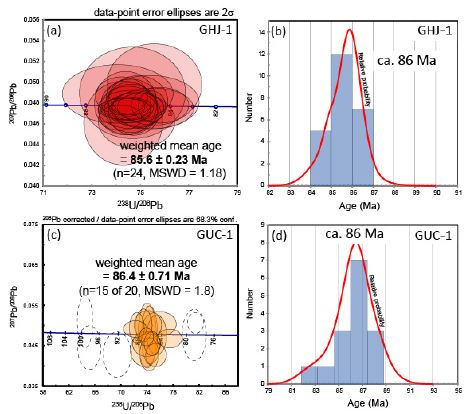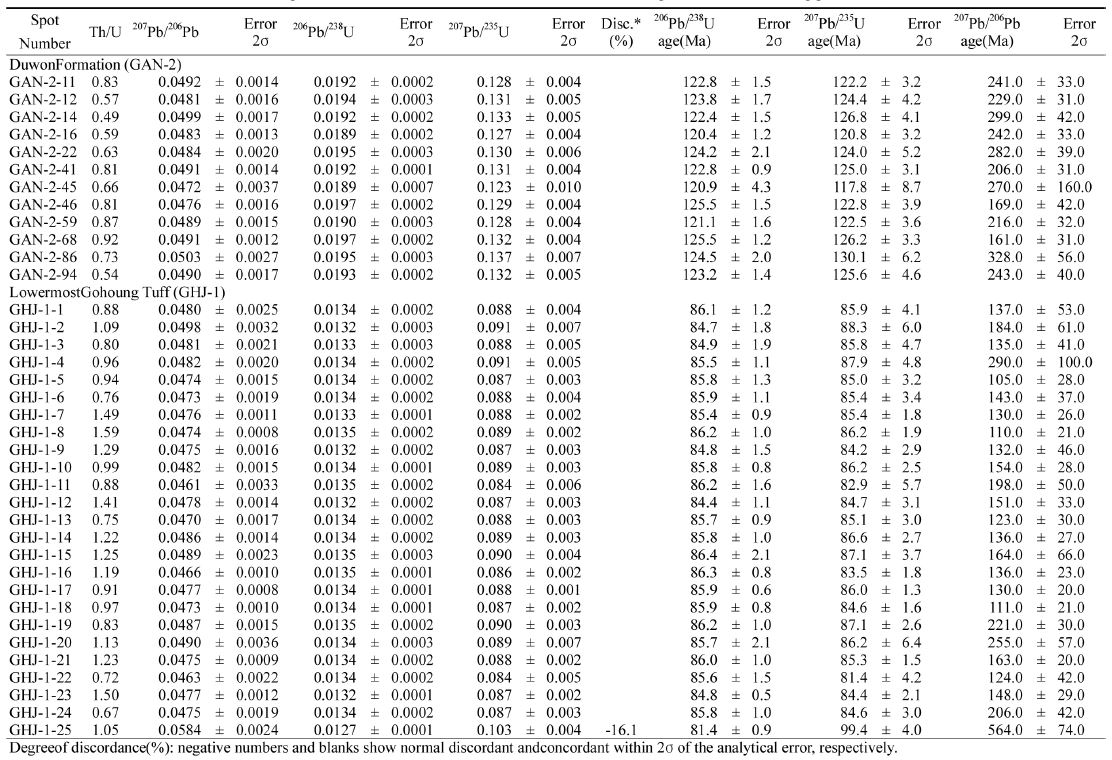
전남 고흥지역에 분포하는 두원층과 고흥응회암의 저어콘 U-Pb 연대
초록
한반도 남부에 위치한 고흥지역에 분포하는 백악기 두원층과 고흥응회암의 지질연대를 구하기 위해 LA-MC-ICP-MS 및 SHRIMP 저어콘 U-Pb 연대를 측정했다. 분석결과 두원층 사암에서 약 123.1±1.1 Ma (n=12)인 가장 젊은 백악기 저어콘의 206Pb/238U 가중평균연대를 구했고, 고흥응회암의 최하부와 최상부에서는 각각 85.6 ± 0.23 Ma와 86.4 ± 0.71 Ma의 206Pb/238U 가중평균연대를 얻었다. 연대측정 결과와 기존 연구결과를 함께 고려하면 두원층은 하부 백악기 앱티안 시기인 약 123 Ma에 퇴적되었으며, 경상누층군 신동층군의 낙동층의 퇴적시기와 대비된다. 고흥응회암은 후기 백악기 코니아시안과 산토니안의 경계 시기인 약 86 Ma에 분출된 것으로 판단된다. 밀양소분지의 다른 지역과는 달리 고흥지역의 두원층과 고흥응회암 사이에는 약 37 Myr의 긴 시간적 공백이 존재하며, 이는 고흥지역의 분지 진화사가 달랐다는 것을 지시한다.
Abstract
The zircon U-Pb dating was performed to determine the maximum depositional age of the Cretaceous Duwon Formation and the eruption age of the Goheung Tuff, which are located in the Goheung area, the southern part of the Korean peninsula. The Duwon sandstone yields a youngest 206Pb / 238U weighted mean age of 123.1 ± 1.1 Ma(n=12), and the 206Pb/238U weighted mean ages of the lowermost and uppermost parts of the Goheung Tuff are 85.6 ± 0.23 Ma and 86.4 ± 0.71 Ma, respectively. Considering our age-dating results together with previous workers, the Duwon Formation is interpreted to have been deposited at ca. 123 Ma (Aptian), and can be correlated with the Nakdong Formation of the Sindong Group in the Gyeongsang Basin. The eruption age of the Goheung Tuff is considered to be ca. 86 Ma, the boundary between the Coniacian and Santonian. Unlike other regions of the Milyang Subbasin, there is a long time gap of ca. 37 Myr between the Duwon Formation and Goheung Tuff, suggesting that the basin history of the Goheung area was different from the Milyang Subbasin.
Keywords:
Goheung, Duwon Formation, Goheung Tuff, U-Pb dating, Cretaceous키워드:
고흥, 두원층, 고흥응회암, U-Pb 연대측정, 백악기1. 서 론
중생대 백악기 동안 활동성 대륙연변부 환경에 놓인 동아시아 지역에서는 크고 작은 다수의 퇴적분지들이 형성되었다(GSK, 1999). 한반도에도 가장 큰 규모의 육성퇴적분지인 경상분지를 비롯하여 여러 지역에 10여개 이상의 다양한 백악기 소분지들이 형성되었다. 이들 분지들을 채우고 있는 백악기 지층은 경상누층군이 대표적이다.
전라남도 고흥지역에도 경상누층군에 해당하는 두원층과 고흥응회암을 포함하는 다양한 암체들이 분포한다(그림 1). 고흥지역은 지리적으로는 한반도의 최남단부이며 지질학적으로는 경상분지의 남서쪽 끝부분이지만, 이 지역을 경상분지의 일부로 간주해야 하는지 아니면 독립적인 소분지로 다루어져야 하는지에 대해서는 아직까지 체계적이고 종합적인 연구가 이루어지지 않았다. Cho (2000)에 의해 처음으로 “고흥분지”라는 용어가 사용되었지만 아직 분지의 명확한 경계 설정이나 경상분지와 독립적인 분지발달사에 대한 연구자료가 부족하여 별개의 소분지로 규정하기에는 불확실한 상태이다. 고흥분지 최하부의 두원층은 1:250,000 목포도폭(NIGM, 1973)에서 경상분지 유천층군에 대비되는 능주층군의 일부로 설정되었으나 고흥반도의 화산분출물에 대한 연구가 이루어지면서 경상분지 하양층군과 대비되었다(Yun and Hwang, 1988). 이후 식물화석(Bennettitales, conifers, ferns) 연구를 통해 두원층은 백악기 전기에 해당하는 신동층군에 대비된다고 수정 제안되었다(Kenrick et al., 2000). 하지만 지금까지 두원층의 정확한 퇴적시기와 신동층군 내 퇴적층들과의 층서대비에 대해서 명확히 규명되지 않았다. 1:50,000 고흥도폭(Kim et al., 2015)이 발간되면서 다수의 화산암체와 심성암체들에 대한 저어콘 U-Pb 연대가 보고되었지만, 두원층의 퇴적연대와 이를 직접 덮은 고흥응회암에 대한 분출연대를 제시할 수 있는 저어콘 U-Pb 연대 측정은 수행되지 않았다(Kim et al., 2015).
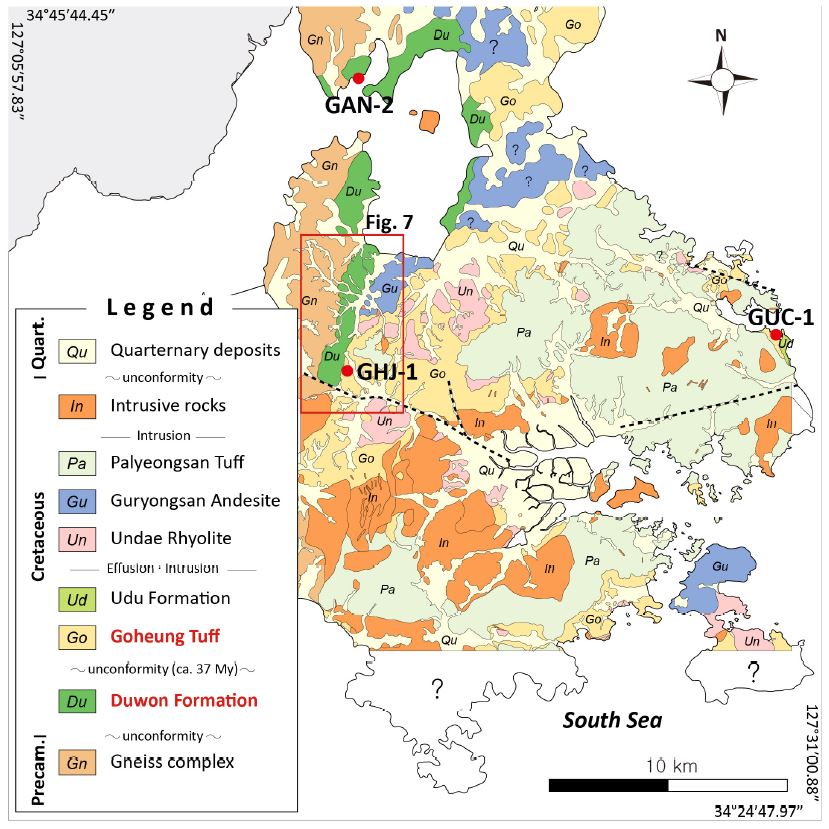
Geologic map of the Goheung area. Red circles indicate the sampling locations (modified from Yun and Hwang, 1988; Cho, 2000; Kim et al., 2015).
이번 연구에서는 지금까지 보고되지 않은 고흥지역 두원층의 퇴적시기와 두원층 상위에 분포하는 고흥응회암의 분출시기를 규명하기 위해 저어콘 U-Pb 연대측정을 수행하였다. 이번 연구결과는 고흥지역의 분지 진화사를 이해하는데 중요한 기초자료로 사용될 수 있을 것으로 기대된다.
2. 일반지질
중생대 백악기 동안 고태평양판(이자나기판)과 유라시아판 간의 사각섭입에 의해 동북아시아 지역에 많은 육성 퇴적분지들이 형성되었고, 그 결과 한반도 전역에도 소규모의 분지들이 형성되었다(그림 1). 한반도의 백악기 소분지들은 대부분 북동-남서의 주향을 가지는 좌수향 주향이동단층에 의해 형성된 인리형분지(pull-apart basin)들로 해석되었다(Lee, 1999; Ryang, 2013). 반면, 한국의 남동부를 차지하는 가장 큰 백악기 육성분지인 경상분지는 소분지들과는 다르게 대륙호 화산활동에 의한 배호확장(back-arc rifting)에 의해 형성된 것으로 해석되었다(Chough and Sohn, 2010). 한편 Cheon (2018)은 최근 경상분지의 경계 및 내부에 존재하는 구조적 자료를 바탕으로 한 연구에서 경상분지는 좌수향의 주향이동 단층작용과 더불어 고태평양판의 섭입된 슬랩이 남동쪽으로 퇴각하면서 인장력이 더해진 결과 형성된 것으로 해석하였다.
고흥지역은 서쪽 영남육괴의 지리산 편마암 복합체를 기반암으로 최하부에 두원층이 부정합의 관계로 퇴적되었다. 두원층은 유문암 및 안산암질 화산암과 관입암류에 의해 덮이거나 관입되며, 화강암류가 다시 이들을 관입하였다(그림 1). 고흥지역 백악기 지층에 대한 기존연구로는 두원층에 대한 고환경(Cho, 2000) 및 고생물 연구(Kenrick et al., 2000), 화산암에 대한 화산층서 및 암석학적 연구(Yun and Hwang, 1988)와 역학적 특성연구(Kim et al., 2004), 화강암류에 대한 절대연대 및 지화학(Park et al., 1997; Yoon et al., 1999)과 고응력장 분석연구(Kang et al., 2008) 등이 있다. 또한 1:50,000 고흥도폭(Kim et al., 2015)이 발간되면서 Yun and Hwang (1988)에 의해 비봉산안산암으로 명명되었던 안산암은 현정질 암체인 전기의 구룡산안산암과 비현정질 암체인 후기의 포두안산암으로 분리되고, 고흥응회암과 팔영산응회암 사이에 고흥반도 동편 해안가에서 관찰된 우두층이 설정되는 등 일부 층서가 수정되었다. 이와 함께 구룡산안산암(ca. 84~85 Ma), 팔영산응회암(ca. 81~85 Ma), 오무산섬록암(ca. 82 Ma), 포두안산암(ca. 81~82 Ma), 별학산유문암(ca. 80 Ma), 화강암류(75~76 Ma) 등에 대한 SHRIMP 저어콘 U-Pb 절대연대가 제시되었다(Kim et al., 2015, 2016). 또한 고흥지역에서 화산암류에 발달하는 주상절리(Son and Ahn, 2016)와 두원층 역암에서 특이한 형태로 변형된 역(Chae, 2017)이 보고되는 등 최근 다양한 연구들이 이루어지고 있다.
두원층은 고흥반도 북서쪽에 남북 방향으로 길게 대상으로 분포하며, 역암과 사암, 역질 사암이 주된 암상이며, 층의 상부로 가면서 이암과 셰일이 협재하는 특징을 보인다. 두원층의 고수류 방향은 NW-SE와 SW-NE 방향이 우세한 것으로 보고되었다(Cho, 2000). 두원층의 퇴적환경은 선상지와 선상지 말단의 망상하천으로 해석되었으며, 최상부에 일부 적색층이 관찰된다(Cho, 2000). 식물화석에 근거한 두원층의 퇴적시기는 바레미안(Barremian: 125-129.4 Ma) 또는 그 이전으로 보고되었다(Cho, 2000; Kenrick et al., 2000).
3. 분석방법
고흥지역 두원층의 퇴적시기 및 고흥응회암의 분출시기를 밝히기 위해 두원층 하부에서 1개의 사암 시료(GAN-2)와 고흥응회암의 최하부 및 최상부에서 1개씩 총 2개의 응회암 시료(최하부: GHJ-1, 최상부: GUC-1)를 채취하였다(그림 1). 채취한 시료들은 분쇄한 후 체질(sieving)과 중액분리, 자성분리를 통해 중광물을 농집시킨 후 실체현미경을 이용한 수작업(hand-picking)을 통해 저어콘 광물을 분리했다. 분리한 저어콘은 에폭시로 마운팅 후 연마편을 제작하였다. 분석 전에 주사전자현미경(SEM)을 이용해 후방산란전자(BSE)와 음극선 발광(CL) 이미지를 얻어 크랙(crack) 및 포유물(inclusion)을 피해 분석점의 위치를 결정했다(그림 2). 모든 시료의 분석은 한국기초과학지원연구원(KBSI)에서 이루어졌다. GAN-2와 GHJ-1시료는 LA-MC-ICP-MS 장비를 이용하고, GUC-1 시료는 SHRIMP 장비를 사용해 U-Pb 절대연대를 측정했다.

Scanning electron microscope cathodoluminescence (SEM-CL) images of the sectioned zircon grains used in final age calculation. (a) the Duwon sandstone(GAN-2). (b) the lowermost part of the Goheung Tuff (GHJ-1). (c) the uppermost part of the Goheung Tuff (GUC-1). Diameter of red circle: 15 μm (a and b), 30 μm (c)
사암에서는 무작위하게 순차적으로 저어콘들을 분석한 반면 응회암시료에 대해서는 자형 및 뚜렷한 진동누대(oscillatory zoning)를 보이는 저어콘들을 선별적으로 분석했다. LA-MC-ICP-MS를 통해 두원층 사암 시료(GAN-2)의 저어콘에서 100점 그리고 최하부 고흥응회암 시료(GHJ-1)의 저어콘에서 25점을 분석했다. 직경 15 µm의 레이저빔을 이용해 시료 분석점 5개 당 하나의 91500 표준 저어콘(1065.4 ± 0.3 Ma; Wiedenbeck et al., 1995) 시료를 함께 분석했다. 분석을 통해 얻은 원자료는 Iolite 2.5(Paton et al., 2011)와 ISOPLOT 프로그램(Ludwig, 2008)을 통해 처리했다. 최상부 고흥응회암 시료(GUC-1)에서 분리된 저어콘은 SHRIMP를 사용해 직경 30 µm의 이온빔으로 자형 및 뚜렷한 진동누대를 보이는 저어콘들에 대해 선별적으로 22점을 분석했다. 시료 분석점 3개 당 하나의 FC-1 표준 저어콘(1099.0 ± 0.6 Ma; Paces and Miller, 1993)을 분석했고, 분석을 통해 획득한 원자료는 SQUID 2.5와 ISOPLOT 프로그램(Ludwig, 2008)을 이용해 처리했다. 단일 저어콘 입자에서 연대가 섞이거나 납손실(Pb loss)에 의한 효과를 제거하기 위해 15%이상의 불일치 또는 10%이상의 역불일치 연대를 보이는 분석값은 신뢰할 수 없는 자료로 간주해 연대계산에서 제외했다(cf., Gehrels et al., 1995).
4. 분석결과
분석에 사용된 저어콘의 크기와 형태는 시료에 따라 다소 차이를 보인다. 고흥응회암의 경우 GHJ-1 저어콘은 약 40-150 µm, GUC-1은 약 50-300 µm의 길이 범위를 가지며 대체로 짧은 단주상 내지 주상의 저어콘들이 우세하고 GHJ-1 보다 GUC-1의 저어콘들이 조금 더 크고 긴 형태를 보인다(그림 2). 두원층 사암(GAN-2)에서 산출되는 저어콘들은 약 50-180 µm의 길이 범위를 가지며, 대부분 마모된 둥근 형태를 가지지만 백악기 연대를 나타내는 젊은 저어콘들은 상대적으로 마모가 적은 자형을 보이고 CL 사진에서 상대적으로 밝게 나타났다(그림 2). 분석 후 연대를 얻는데 이용된 대부분의 저어콘들은 뚜렷한 진동누대와 함께 자형을 나타내며, 응회암시료보다 비교적 이동거리가 길었던 사암시료의 저어콘들이 원마도가 좋은 편이다(그림 2). 그리고 이들은 선캄브리아기 연대를 나타내는 2개(GUC-1_4.1과 6.1)를 제외한 분석점에서 Th/U이 0.2를 초과하기 때문에 연대 계산에 이용된 대부분의 저어콘들은 마그마로부터 결정화된 화성기원임을 지시한다(표 1, 2; Hoskin and Schaltegger, 2003; Hartmann and Santos, 2004).
두원층에서는 120.4 ± 1.2 Ma의 단일 저어콘 최소연대(youngest single grain age)와 13개의 분석점에서 약 120-136 Ma 범위의 백악기 연대를 얻었다(표 1). 또한 13개의 분석 값들은 모두 일치곡선 상에 놓이지만, 통계적 처리(t-test)를 거치며 1개가 제외되어 123.1 ± 1.1 Ma (n=12)의 206Pb/238U 가중평균연대를 구했다(그림 3).

LA-MC-ICP-MS zircon U-Pb ages of the Duwon Formation and lowermost Goheung Tuff in the Goheung peninsula, Korea.
고흥응회암의 최하부 시료는 모두 백악기인 약 81-86 Ma의 비교적 좁은 연대범위를 나타낸 반면, 최상부 시료는 백악기에서 선캄브리아기에 해당하는 약 78-1847 Ma의 상당히 넓은 연대범위를 보여준다(표 2). 최하부 고흥응회암에서 구해진 분석값들 중 1개(표 1; GHJ-1-25) 값을 제외하면 일치곡선 상에 잘 놓이므로 이를 제거한 후 총 24개의 분석값을 이용하여 85.6 ± 0.23 Ma의 206Pb/238U 가중평균연대를 구했다(그림 4a). 최상부 시료에서는 백악기 연대를 나타내지 않는 2개의 분석점들을 제외하였고, 나머지 20개의 분석값 중 통계적으로 일치곡선에서 벗어난 5개의 분석점을 제외한 15개의 분석값을 이용하여 86.4 ± 0.71 Ma의 206Pb/238U 가중평균연대를 얻었다(그림 4c).
5. 토 의
5.1 두원층의 퇴적시기 및 지층 대비
두원층의 퇴적시기에 관해서는 과거부터 신동층군과 하양층군 중 어디에 대비될 것인가에 대해 논란이 있었으나, 최근 Kenrick et al. (2000)은 식물화석 연구를 통해 두원층의 퇴적시기가 바레미안(Barremian: 129.4-125.0 Ma)보다 젊지 않다고 해석하면서, 두원층이 백악기 전기에 해당하는 신동층군에 대비된다고 제안하였다. 하지만 정량적인 퇴적시기를 얻을 수 있는 두원층의 절대연대측정 연구가 수행되지 않았기 때문에 두원층이 신동층군을 구성하는 세 층들(낙동층, 하산동층, 진주층) 중 어떤 층에 대비되는지는 규명되지 않았다.
두원층에서 최초로 수행된 쇄설성 저어콘의 절대연대 측정결과 두원층 사암의 단일 저어콘 최소연대는 약 120 Ma이며, 최소연대군집을 이용해 구한 가중평균연대는 123.1±1.1 Ma (n=12)를 보인다(그림 3). 분석점들 중 저어콘의 형태학적 특징 및 CL 영상과 일치곡선상의 아이소크론 군집 및 확률밀도함수곡선을 고려했을 때, 단일 저어콘 최소연대를 보이는 저어콘을 포함해 계산에 이용된 12개의 저어콘들은 모두 동일기원(연대)의 암체에서 유래된 것으로 판단된다(그림 2, 3, 5). 쇄설성 저어콘의 U-Pb연대를 이용하여 퇴적층의 최대퇴적시기를 추정할 경우 일반적으로 2σ의 오차범위 내에서 최소 3개 이상의 가장 젊은 연대가 겹치는 저어콘들의 가중치 평균연대[YC2σ (3+)]를 이용하는 것이 가장 대표성을 가지는 것으로 알려져 있다(Coutts et al., 2019). 따라서 두원층의 최대퇴적시기는 123.1±1.1 Ma로 보는 것이 합리적이며, 이 연대는 백악기의 앱티안(Aptian: 125.0~113.0 Ma)에 해당되므로, 식물화석에 의한 퇴적시기보다는 다소 젊은 연대를 지시한다. 최대퇴적연대는 실제 퇴적연대와 같거나 보다 더 오래된 연대를 지시하지만 두원층에서 보고된 식물화석을 이용한 고생물학적 자료와 이번 연구에서 구한 최대퇴적연대를 함께 고려할 때, 이번연구에서 구해진 최대퇴적연대는 실제 퇴적연대를 지시할 가능성이 높은 것으로 판단된다(그림 6).
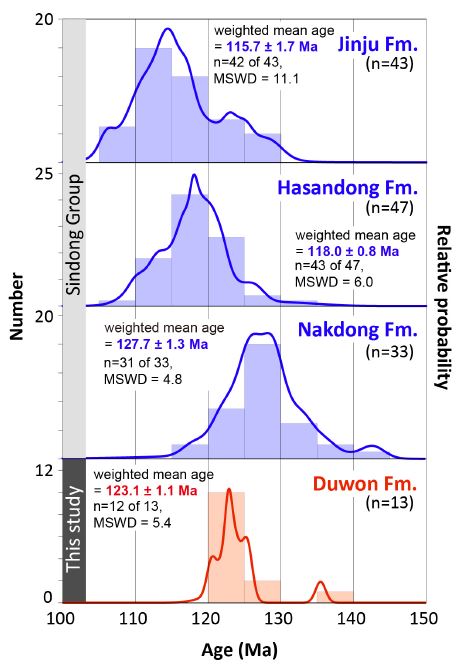
Probability-density plots of Cretaceous detrital zircon U-Pb ages from the Sindong Group (Nakdong, Hasandong, and Jinju formations) and Duwon Formation. The age data of the Sindong Group are from Lee, T.-H. et al. (2010), Lee, Y.I. et al. (2010), Lee (2016), Lee et al. (2017).

Stratigraphic correlation of the Sindong Group and Duwon Formation based on biostratigraphic data. (1) plant (Kenrick et al., 2000), (2) bivalve adn plant (Chang, 1975), (3) mollusk (Kobayashi and Suzuki, 1936), (4) charophyte (Seo, 1985), (5) charophyte (Choi, 1989), bivalve (Chang et al., 2003; Kozai et al., 2005), (6) bivalve (Yang, 1975, 1979, 1982), mollusk (Yun and Yang, 2001), and Theropod teeth (Lee, 2007), (7) Ornithopod tooth (Lee and Lee, 2007), (8) mollusk (Kobayash and Suzuki, 1936), (9) palynomorph (Choi, 1985; Choi and Park, 1987), (10) palynomorph (Yi et al., 1994), (11) insect (Park et al., 2013), (12) conchostraca (Park and Chang, 1998), (13) insect (Nam and Kim, 2016)
시기적으로 앱티안은 후기 쥐라기 동안 상부에 놓인 유라시아 대륙지각과 편평하게 섭입(flat-lying subduction)하는 고태평양 해양지각에 의해 한반도 지역에 화성활동이 없었던 시기(magmatic quiescence: 약 160~120 Ma) 이후, 재활성화된 시기(약 120 Ma)이며, 재활성화된 화성활동이 한반도의 북서쪽에서부터 시작되었다는 결과와 고흥지역 두원층의 퇴적물 공급 방향이 북서에서 남동으로 향했다는 결과와도 잘 일치한다(Cho, 2000; Kiminami and Imaoka, 2013; Kim et al., 2016). 이번 연구에서 얻은 두원층의 최대퇴적시기는 123.1±1.1 Ma로 앱티안에 해당된다. 하지만 이번 연구에서 분석한 시료는 두원층 하부에서 채취한 것이며, 상부의 고흥응회암과의 연대 차이가 크기 때문에 두원층의 퇴적시기를 앱티안으로 한정하기는 어렵고 향후 두원층 상부시료에 대한 추가 분석이 필요하다.
이번 연구에서 얻은 연대측정 결과와 기존에 보고된 식물화석 연구 결과를 함께 고려하면, 두원층의 퇴적시기는 신동층군의 최하부층인 낙동층의 퇴적시기와 대비된다. 두원층의 식물화석은 일반적으로 낙동층과 유사한 혼합형 식물군의 특징을 보이는 것으로 보고되었다(Kenrick et al., 2000). 하지만 낙동층의 중부와 상부에서 온대 내지 아열대 기후 기원의 나무고사리화석이 특징적으로 산출되는 반면 두원층에서는 산출되지 않는다는 점과 낙동층에서는 붉은색 퇴적층이 나타나지 않고 석회질 및 버티졸고토양 등이 부분적으로 발달된다는 점 등은 두원층과 낙동층의 환경 차이를 지시하는 것으로 생각된다. 따라서 두원층과 신동층군의 정확한 대비를 위해서는 추가 연구가 필요할 것으로 보인다.
5.2 고흥응회암의 분출시기
고흥응회암의 형성시기에 대해서는 경상누층군의 유천층군에 대비된다는 것 외에는 지금까지 보고된 바 없다(KIGAM, 1995). 이번 분석 결과 최상부 시료에서 2개의 선캄브리아기 연대가 얻어졌지만 이는 화산분화 시 재동된 기존암편에서 유래된 것으로 볼 수 있으므로 해석에서 제외하였다. 또한 고흥응회암보다 층서적으로 상위에 위치하는 구룡산안산암(ca. 84~85 Ma)과 팔영산응회암(ca. 81~85 Ma)의 저어콘 SHRIMP U-Pb 연대보다 젊은 약 78 Ma의 연대도 해석에서 제외하였다. 분석 결과 고흥응회암 최하부에서 85.6 ± 0.23 Ma 그리고 최상부에서 86.4 ± 0.71 Ma의 오차범위 내에서 일치하는 206Pb/238U 가중평균연대가 구해졌으므로(그림 4), 고흥응회암의 분출연대는 약 86 Ma라고 할 수 있다, 이 시기는 후기 백악기의 코니아시안(Coniacian: 86.3~89.8 Ma)과 산토니안(Santonian: 83.6~86.3 Ma)의 경계부에 해당한다(그림 4). 이와 같은 결과는 층서적 횡절관계를 고려할 때, 고흥응회암 이후에 관입 및 분출한 것으로 알려진 구룡산안산암(ca. 85 Ma)과 팔영산응회암(ca. 84 Ma)의 형성시기와도 잘 일치한다(Kim et al., 2015). 그러므로 이번 연구에서 얻은 약 86 Ma의 고흥응회암 연대는 주변 암체의 연대와 잘 부합하는 분출연대로 판단된다.
5.3 연대측정 결과의 지질학적 의미
경상분지 밀양소분지의 대부분 지역에서는 신동층군, 하양층군, 유천층군이 순차적으로 분포한다. 하지만 이번 연구결과 고흥지역에서는 두원층(약 123 Ma)과 두원층 직상부에 놓이는 고흥응회암(약 86 Ma) 간에 약 37 Myr의 시간적 공백이 존재한다. 현재 경상분지 내 대부분의 지역에서는 후기 백악기 화산호 분출물이 분지의 동쪽에 집중적으로 분포하는데 반해 경상분지 밀양소분지의 남부 또는 남서부에서는 아치형의 화산호 분출에 의해 부정합이 나타난다. 암층서적으로 고흥지역 두원층에서 역암 내지 사암이 우세하고 상부에 일부 적색 사암 또는 이암이 협재 하지만, 이를 제외하면 상부 신동층군 및 하양층군의 퇴적특성이 관찰되지 않는 점에서 순차적 층서를 보이는 밀양소분지의 다른 지역과는 차이를 보인다.
고흥지역의 부정합은 지질학적으로 세 가지의 가능성을 내포한다. 첫 번째 가능성은 고흥지역에 두원층의 퇴적 이후, 밀양소분지의 다른 지역과는 달리 추가적인 퇴적작용이 일어나지 않았을 가능성이고, 두 번째는 두원층 상위에 퇴적층이 쌓인 후 융기되어 삭박되었을 가능성이다. 세 번째는 두원층 상위에 분포하던 쇄설성 퇴적암류가 퇴적 이후 분출된 화산암류에 덮여 지하 깊숙이 매몰되어 있을 가능성이다. 첫 번째 가능성은 퇴적분지 진화과정에서 두원층 퇴적 이후 특정 기간 동안 고흥 및 인근지역에 퇴적작용의 중단이 있어야 하며, 이는 당시 구조운동에 대한 남부지역 고유의 지각 반응이 있었거나, 남부지역에서 상대적으로 얇은 퇴적체(두원층)로 인해 자체 하중에 의한 충분한 퇴적공간이 확보되지 못해 발생할 수 있다. 약 90 Ma에 일어난 해령섭입(ridge subduction)에 의해 한반도와 일본 열도, 중국 동북부 지역이 빠르게 융기했다는 연구결과는 두 번째 가능성을 지시한다(Choi and Lee, 2011). 마지막 세 번째 가설에서 분출된 화산암체는 하양층군에 대비되는 암체의 퇴적 이후 분지의 특정 구역(경상분지의 동, 남 및 고흥 인근)에서만 추가 하중으로 작용했으며, 이때 화산암체에 의해 추가로 하중이 가해진 지역의 암권이 주변 지역과 비교해 상대적으로 하부로 약간 쳐져있을 가능성이 있을 것으로 생각된다. 고흥응회암체와 두원층이 직접적으로 접하며 후기 관입암에 의한 영향을 비교적 적게 받은 두원층 남부에 분포하는 지층의 경사값이 두원층 하부에서 상부(동쪽: 고흥응회암 분포지)로 갈수록 대체로 증가하는 경향을 보이는데, 이는 화산암체의 하중에 의한 영향을 나타내는 것으로 판단된다(그림 7). 또한 현존하는 화산체 및 화산호 인접부에서 수차례 보고된 화산체 하중에 의한 침강 효과 및 영향은 이와 같은 해석을 뒷받침한다(Moore, 1970; Ten Brink and Watts, 1985; Thurber and Gripp, 1988; Watts, 1994; Huppert et al., 2015). 최근 경상분지 내 화산암체 인접부에 분포하는 퇴적암의 주향과 경사 분포 자료 역시 경상분지 내 백악기 말 화산호 하중이 경상분지 지층들의 경동 및 침강에 상당한 영향력을 끼쳤을 가능성이 제기되면서 경상분지 내 분포하는 화산암류의 구조적 역할에 대한 중요성이 제기되었다(Cheon, 2018). 고흥응회암(약 300 m)과 팔영산응회암(약 600 m)의 보고된 연대와 층후를 고려하면 고흥지역 역시 짧은 기간 동안 화산활동에 의해 막대한 양의 분출물이 퇴적되었고, 이는 화산체가 인접한 곳에 존재했음을 지시한다. 이러한 사실은 고흥반도 내 칼데라가 존재했다는 기존연구결과와도 잘 일치한다(Yun and Hwang, 1988; Chough and Sohn, 2010). 따라서 고흥지역 동부에서도 두원층의 퇴적 이후 추가로 가해진 대규모 화산암체의 하중에 의한 영향으로 암권이 비교적 하부로 가라앉았을 가능성이 있다. 이에 따라 고흥지역에서는 북동쪽에 위치하는 밀양소분지 다른 지역에 비해 융기가 적게 일어났고, 경상분지 중북부 서편에 위치하는 신동 및 하양층군에 대비되는 일련의 퇴적암체들이 노출되지 않았을 가능성이 있다. 하지만 이와 같은 가설을 검증하기 위해서는 구조지질학적 조사와 화산암체 하부에 대한 지구물리탐사 등 체계적이고 종합적인 추가 연구가 필요할 것으로 판단된다.
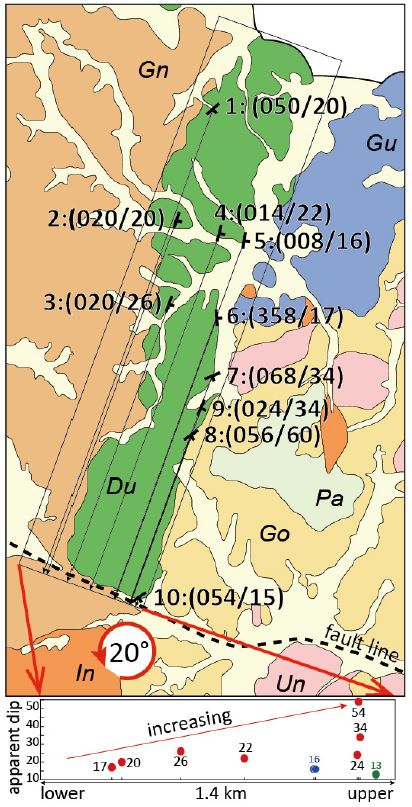
Apparent dip distribution between the lower and upper part of the Duwon Formation along the main dip direction. Data No. 5 and 6 (blue circles) might be disturbed by the Guryongsan intrusive rock after the extrusion of the Goheung tuff. Datum No. 10 (green circle) was also likely to be affected by the adjacent fault. Except for these three points, the apparent dips tend to increase with age. Most data are from the Kim et al. (2015) except two (No.3 and 5).
6. 결 론
전라남도 고흥지역에 분포하고 있는 백악기 두원층과 고흥응회암에 대한 저어콘 U-Pb 절대연대측정 결과, 두원층은 약 123 Ma에 해당하는 전기 백악기 앱티안에 퇴적이 시작되었으며, 두원층을 덮고 있는 고흥응회암은 후기 백악기 코니아시안과 산토니안의 경계 시기인 약 86 Ma에 분출된 것으로 해석된다. 두원층의 퇴적연대와 환경을 고려하면 두원층은 경상누층군 신동층군의 최하부 지층인 낙동층의 퇴적시기와 대비된다. 연속적인 퇴적기록을 보이는 밀양소분지의 다른 지역과는 달리 고흥지역의 두원층과 고흥응회암 사이에는 약 37 Myr의 긴 시간적 공백이 존재한다. 이는 두원층 퇴적 이후 오랜 기간 동안 퇴적작용이 중단되었거나, 다른 지역과 유사하게 순차적 퇴적이 일어났지만 융기 후 삭박되었거나, 또는 이후 분출한 화산암체에 의해 지표에 노출되지 않았을 가능성을 지시한다. 하지만 정확한 해석을 위해서는 추가 연구가 필요할 것으로 판단된다.
Acknowledgments
이 연구는 한국연구재단의 중견연구자지원사업에 의해 수행되었다(NRF-2017R1A2B4007877). 심사과정에서 유익한 조언을 해 주신 이용일 교수님과 백인성 교수님, 최태진 교수님께 감사드린다.
References
- Chae, Y.-U., 2017, Classification and Formation Mechanism of Deformed Cobbles from the Early Cretaceous Duwon Formation, Goheung Basin. Master’s thesis, Pusan National University, Busan, Korea, 104 p (in Korean with English abstract).
- Chang, K.H., 1975, Cretaceous stratigraphy of southeast Korea. Journal of the Geological Society of Korea, 11, 1-23.
-
Chang, K.H., Suzuki, K., Park, S.O., Ishida, K. and Uno, K., 2003, Recent advances in the cretaceous stratigraphy of Korea. Journal of Asian Earth Science, 21, 937-948.
[https://doi.org/10.1016/S1367-9120(02)00142-6]

- Cheon, Y., 2018,Tectonic Evolution of the Cretaceous Gyeongsang Basin Focused on the Jinju, Daegu, and Uiseong Blocks. Ph.D. Thesis, Pusan National University, Busan, Korea, 172 p (in Korean with English abstract).
- Cho, S.H., 2000, A Study on Paleoenvironments of the Cretaceous Sedimentary Basin in the Northern Part of Koheung Area, Chonnam Province. Ph.D. Thesis, Chonnam National University, Gwangju, Korea, 160 p (in Korean with English abstract).
- Choi, D.K., 1985, Spores and pollen from the Gyeongsang Supergroup, southeastern Korea and their chronologic and paleoecologic implications. Journal of the Paleontological Society of Korea, 1, 33-50.
- Choi, D.K. and Park, J.B., 1987, Palynology of the Jinju Formation (Lower Cretaceous), Waegwan-Daegu and Jinju areas, Korea. Journal of the Paleontological Society of Korea, 3, 28-43.
- Choi, S.-J., 1989, Fossil charophytes from the Nagdong Formation in Seonsangun, Gyeongsangbukdo, Korea. Journal of the Paleontological Society of Korea, 5, 28-38.
-
Choi, T. and Lee, Y.I., 2011, Thermal histories of Cretaceous basins in Korea: Implications for response of the East Asian continental margin to subduction of the Paleo‐Pacific Plate. Island Arc, 20, 371-385.
[https://doi.org/10.1111/j.1440-1738.2011.00771.x]

-
Chough, S.K. and Sohn, Y.K., 2010, Tectonic and sedimentary evolution of a Cretaceous continental arc-backarc system in the Korean peninsula: new view. Earth-Science Reviews, 101, 225-249.
[https://doi.org/10.1016/j.earscirev.2010.05.004]

-
Coutts, D.S., Matthew, W.A. and Hubbard, S.M., 2019, Assessment of widely used methods to derive depositional ages from detrital zircon populations. Geoscience Frontiers.
[https://doi.org/10.1016/j.gsf.2018.11.002]

-
Gehrels, G.E., Dickinson, W.R., Ross, G.M., Stewart, J.H. and Howell, D.G., 1995, Detrital zircon reference for Cambrian to Triassic miogeoclinal strata of western North America. Geology, 23, 831-834.
[https://doi.org/10.1130/0091-7613(1995)023<0831:DZRFCT>2.3.CO;2]

- Geological Society of Korea, 1999, Geology of Korea. Sigma Press, Seoul, 802 p.
-
Hartmann, L.A. and Santos, J.O.S., 2004, Predominance of high Th/U, magmatic zircon in Brazilian Shield sandstones. Geology, 32, 73-76.
[https://doi.org/10.1130/G20007.1]

-
Hoskin, P.W. and Schaltegger, U., 2003, The composition of zircon and igneous and metamorphic petrogenesis. Reviews in mineralogy and geochemistry, 53, 27-62.
[https://doi.org/10.2113/0530027]

-
Huppert, K.L., Royden, L.H. and Perron, J.T., 2015, Dominant influence of volcanic loading on vertical motions of the Hawaiian Islands. Earth and Planetary Science Letters, 418, 149-171.
[https://doi.org/10.1016/j.epsl.2015.02.027]

-
Kang, S.-S., Lim, C.-G., Sim, H.-M., Yoon, J.-H. and Kim, C.-B., 2008, Late Cretaceous to Early Tertiary Paleostress from Healed Microcracks of Cretaceous Granites in Goheung Area, Jeonnam. Journal of Korean Earth Science Society, 29, 255-262 (in Korean with English abstract).
[https://doi.org/10.5467/JKESS.2008.29.3.255]

- Kenrick, P., You, H.-S., Koh, Y.-K., Kim, J.-Y., Cho, S.-H. and Kim, H.-G., 2000, Cretaceous plant fossils from the Kohung area, Chonnam, Korea. Journal of Paleontological Society of Korea, 16, 45-56.
- KIGAM, 1995, Geological map of Korea (1: 1,000,000).
- Kim, H.-G., Koh, Y.-K. and Oh, K.-H., 2004, A Study on the Mechanical Properties of the Cretaceous Tuffs in Goheung Area. The Journal of Engineering Geology, 14, 273-285 (in Korean with English abstract).
-
Kim, S.W., Kwon, S., Park, S.-I., Lee, C., Cho, D.-L., Lee, H.-J., Ko, K. and Kim, S.J., 2016, SHRIMP U-Pb dating and geochemistry of the Cretaceous plutonic rocks in the Korean Peninsula: A new tectonic model of the Cretaceous Korean Peninsula. Lithos, 262, 88-106.
[https://doi.org/10.1016/j.lithos.2016.06.027]

- Kim, S.W., Park, S.-I., Kee, W.-S. and Kim, B.C., 2015, Geological Report of the Goheung Sheet (1:50,000). Korea Institute of Geoscience and Mineral Resources, 54 p (in Korean with English abstract).
-
Kiminami, K. and Imaoka, T., 2013, Spatiotemporal variations of Jurassic-Cretaceous magmatism in eastern Asia (Tan-Lu Fault to SW Japan): evidence for flat-slab subduction and slab rollback. Terra Nova, 25, 414-422.
[https://doi.org/10.1111/ter.12051]

- Kobayashi, T. and Suzuki, K., 1936, Non-marine shells of the Naktong-Wakino Series. Japanese Journal of Geology and Geography, 13, 243-257.
-
Kozai, T., Ishida, K., Hirsch, F., Park, S.O. and Chang, K.H., 2005, Early Cretaceous non-marine mollusc faunas of Japan and Korea. Cretaceous Research, 26, 97-112.
[https://doi.org/10.1016/j.cretres.2004.11.003]

-
Lee, C., Ryu, I.-C. and Shinn, Y.J., 2017, U-Pb ages of detrital zircons in Lower Cretaceous non-marine successions of the Gyeongsang Basin, Northeast Asia: Implications for sediment provenance. Sedimentary Geology, 353, 125-138.
[https://doi.org/10.1016/j.sedgeo.2017.03.008]

-
Lee, D.W., 1999, Strike-slip fault tectonics and basin formation during the Cretaceous in the Korean Peninsula. Island Arc, 8, 218-231.
[https://doi.org/10.1046/j.1440-1738.1999.00233.x]

- Lee, T.-H., 2016, Formation and evolution of the Gyeongsang Basin: constraints from zircon geochronology and Hf isotope geochemistry. Ph.D. Thesis, Pukyong National University, Busan, Korea, 240 p.
- Lee, T.-H., Park, K.-H., Chun, J.-H. and Yi, K., 2010, SHRIMP U-Pb Zircon Ages of the Jinju Formation and Silla Conglomerate, Gyeongsang Basin. Journal of the Petrological Society of Korea, 19, 89-101 (in Korean with English abstract).
-
Lee, Y.I., Choi, T., Lim, H.S. and Orihashi, Y., 2010, Detrital Zircon geochronology of the Cretaceous Sindong Group, Southeast Korea: Implications for depositional age and Early Cretaceous igneous activity. Island Arc, 19, 647-658.
[https://doi.org/10.1111/j.1440-1738.2010.00717.x]

- Lee, Y.-N. and Lee, H.-J., 2007, The first ornithopod tooth in Korea. Journal of the Paleontological Society of Korea, 23, 213-225 (in Korean with English abstract).
- Lee, Y.-N., 2007, New theropod teeth from the Juji Island (Hasandong Formation), Daedo-ri, Hadong County, South Gyeongsang Province. Journal of the Geological Society of Korea, 43, 151-166 (in Korean with English abstract).
- Ludwig, K.R., 2008, User's manual for Isoplot 3.6: a geochronological toolkit for Microsoft Excel. Berkeley, CA, Berkeley Geochronology Center Special Publication, 4, 77 p.
-
Moore, J.G., 1970, Relationship between subsidence and volcanic load, Hawaii. Bulletin Volcanologique, 34, 562-576.
[https://doi.org/10.1007/BF02596771]

-
Nam, K.-S. and Kim, J.-H., 2016, Reconstruction and Paleoecological implications of Dragonfly Hemeroscopus baissicus Pritykina, 1977 (Hemeroscopidae) from the Lower Cretaceous Jinju Formation in the Jinju Area, Korea. Journal of the Geological Society of Korea, 52, 105-112 (in Korean with English abstract).
[https://doi.org/10.14770/jgsk.2016.52.2.105]

- National Institute of Geology and Mineralogy, 1973, Mokpo (scale 1:250,000).
-
Paces, J.B. and Miller Jr., J.D., 1993, Precise U-Pb ages of Duluth Complex and related mafic intrusions, Northeastern Minnesota: geochronological insights to physical, petrogenic, paleomagnetic, and tectonomagmatic processes associated with the 1.1 Ga midcontinent rift system. Journal of Geophysical Research- Solid Earth, 98, 13997-14013.
[https://doi.org/10.1029/93JB01159]

- Park, S.-O. and Chang, K.-H., 1998, Some Cretaceous conchostracans of Kyongsang Basin. Journal of the Paleontological Society of Korea, 14, 179-199.
- Park, T.-Y., Kim, Y.-H. and Nam, K.-S., 2013, Preliminary research on the aquatic coleopteran, Coptoclava from the Early Cretaceous Jinju Formation. Journal of the Geological Society of Korea, 49, 617-624 (in Korean with English abstract).
- Park, Y.-S., Kim, C.-B., Yoon, C.-H. and Ahn, K.-S., 1997, The Petrochemistry and Geochronology of Cretaceous Plutonic Rocks in the Koheung Area, Chonnam. Journal of The Korean Earth Science Society, 18, 70-83 (in Korean with English abstract).
-
Paton, C., Hellstrom, J., Paul, B., Woodhead, J. and Hergt, J., 2011, Iolite: Freeware for the visualisation and processing of mass spectrometric data. Journal of Analytical Atomic Spectrometry, 26, 2508-2518.
[https://doi.org/10.1039/c1ja10172b]

- Ryang, W.-H., 2013, Characteristics of strike-slip basin formation and sedimentary fills and the Cretaceous small basins of the Korean Peninsula. Journal of the Geological Society of Korea, 49, 31-45 (in Korean with English abstract).
- Seo, S.J., 1985, Lower Cretaceous geology and paleontology (Charophyta) of Central Kyongsang Basin, Korea. PhD Thesis, Kyungpook National University, Daegu, Korea, 177 p.
-
Son, J.-M. and Ahn, K.S., 2016, A Study of Columnar Joint in Goheung, Jeollanam-do, Korea. Journal of The Korean Earth Science Society, 37, 332-345 (in Korean with English abstract).
[https://doi.org/10.5467/JKESS.2016.37.6.332]

-
Ten Brink, U.S. and Watts, A.B., 1985, Seismic stratigraphy of the flexural moat flanking the Hawaiian Islands. Nature, 317, 421.
[https://doi.org/10.1038/317421a0]

-
Thurber, C.H. and Gripp, A.E., 1988, Flexure and seismicity beneath the south flank of Kilauea volcano and tectonic implications. Journal of Geophysical Research: Solid Earth, 93(B5), 4271-4278.
[https://doi.org/10.1029/JB093iB05p04271]

-
Watts, A.B., 1994, Crustal structure, gravity anomalies and flexure of the lithosphere in the vicinity of the Canary Islands. Geophysical Journal International, 119, 648-666.
[https://doi.org/10.1111/j.1365-246X.1994.tb00147.x]

-
Wiedenbeck, M.A.P.C., Allé, P., Corfu, F., Griffin, W.L., Meier, M., Oberli, F., Von Quadt, A. and Spiegel, W., 1995, Three natural zircon standards for U‐Th‐Pb, Lu‐Hf, trace element and REE analyses. Geostandards and Geoanalytical Research, 19, 1-23.
[https://doi.org/10.1111/j.1751-908X.1995.tb00147.x]

- Yang, S.Y., 1975, On a new non-marine pelecypod genus from the upper Mesozoic Gyeongsang Group of Korea. Transaction and Proceedings of the Palenotological Society of Japan, 100, 177-187.
- Yang, S.Y., 1979, Some new bivalve species from the Lower Gyeongsang Group, Korea. Transaction and Proceedings of the Palenotological Society of Japan, 116, 223-234.
- Yang, S.Y., 1982, Geology around the type-locality of Trigonioides (s.s.) kodairai and age of the Nagdong Subgroup. Journal of the Geological Society of Korea 18, 67-72 (in Korean with English abstract).
- Yi, M.-S., Cho, B.-Y., and Chi, J.-M., 1994, Palynomorphs from the Jinju Formation, in the Euiseong area, Korea. Journal of Paleontological Society of Korea, 10, 41-56.
- Yoon, C.-H., Kim, C.-B. and Oh, K.-C., 1999, Lithogeochemistry and Gold Content of Plutonic Rocks distributed in the Mabogsan, Koheung. Economic and Environmental Geology, 32, 585-597 (in Korean with English abstract).
- Yun, C.-S. and Yang, S.-Y., 2001, Occurrence of Cretaceous non-marine bivalve, Nagdongia soni, from the lower part of the Hasandong Formation near Waegwan, Korea. Journal of the Paleontological Society of Korea, 17, 87-97 (in Korean with English abstract).
- Yun, S.H. and Hwang, I.H., 1988, Volcano-Stratigraphy and Petrology of the Volcanic Mass in the Koheung Peninsula, South Cheolla Province, Korea. Journal of Korean Mining Geology, 21, 335-348 (in Korean with English abstract).

